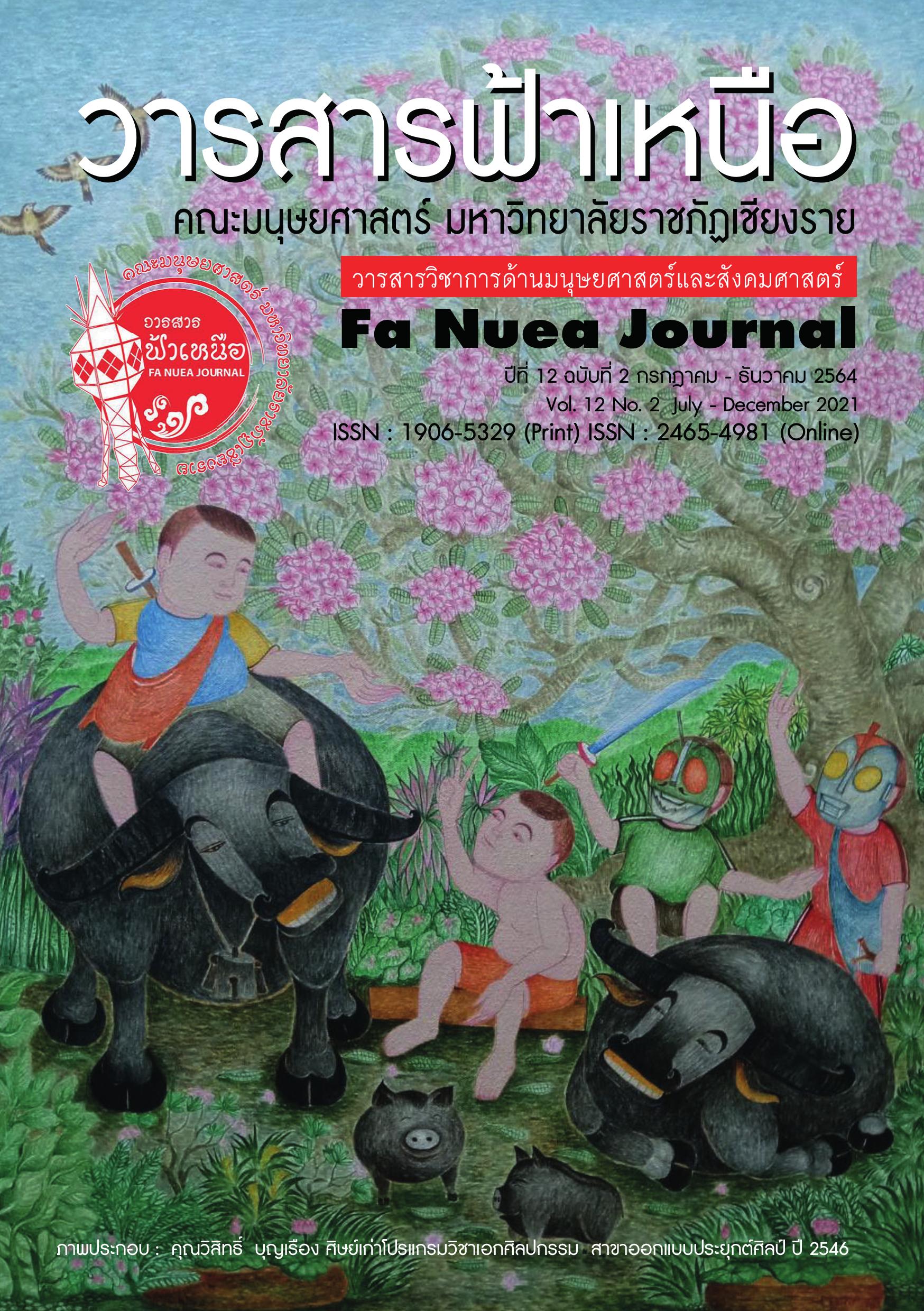Invocation in The Elephant Pacification Poems: a Studies on the Forms of Literature and Context
Main Article Content
Abstract
This research aims to study on the methodology of Thai balladcomposing, namely, prosody and language used. As well as to study thecontext of sacred items, or referred person, who were being worshiped,within the invocation of the elephant pacification poems. The researcherfinds that these poetry characteristics and language used: Kap Chabang,Inthravichian Chan and Wasantadilok Chan, was influenced by Khmer, Pali,Sanskrit and English. Additionally, Khmer, Pali and Sanskrit were consideredto be sacred language used to communicate with the gods. It also finds thatthere are 3 main elements regarding context of sacred items, or referredperson which consist of: The triple gems in Buddhism, gods and monarchs.Although this composing might contain similar characteristic to other Thailiterature’s invocation, it was differed by some elements from the elephantpacification poems. This draws out the implication and interpretation fromThai poets on the branch of study dealing with elephant (Khotchasat) withinthe invocations, and the elephant pacification poems.
Article Details

This work is licensed under a Creative Commons Attribution-NonCommercial-NoDerivatives 4.0 International License.
Articles, information, content, pictures, etc. which have been published in Fa Nuea Journal, are copyright of Fa Nuea Journal. If any person or party wishes to disseminate all or part of it or take any action must be referenced. Do not use for commercial purposes and do not modify (CC-BY-NC-ND). For further details, please access at Attribution-NonCommercial-NoDerivatives 4.0 International (CC BY-NC-ND 4.0)
References
กรมศิลปากร. (2545). คำฉันท์ดุษฎีสังเวย คำฉันท์กล่อมช้าง ครั้งกรุงเก่า และคำฉันท์ คชกรรมประยูร. กองวรรณกรรมและประวัติศาสตร์ กรมศิลปากร.
______. (2564). ตำราช้างในเอกสารโบราณ. กรมศิลปากร.
กุสุมา รักษมณี. (2547). สันสกฤตวิจารณา. แม่คำผาง.
คำยวง วราสิทธิชัย, หม่อมหลวง. (2549). มองวรรณกรรมพระราชพิธีในฐานะวรรณกรรมเฉลิมพระเกียรติ. วรรณวิทัศน์, 6(2), 31-71.
จอมเกล้าเจ้าอยู่หัว, พระบาทสมเด็จพระ. (ม.ป.ป.). ประชุมพระราชนิพนธ์ในรัชกาลที่ 4ภาคปกิณณกะ ภาค 1. ห้องสมุดดิจิทัลวชิรญาณ. shorturl.asia/Kq3E5.
ชัญธิกา มนาปี. (2553). การศึกษาเรื่องคติความเชื่อเรื่องพระเทวกรรมที่ปรากฏในดินแดนไทยตั้งแต่ก่อนพุทธศตวรรษที่ 19 จนถึงสมัยปัจจุบัน. [สารนิพนธ์ปริญญาบัณฑิต]. มหาวิทยาลัยศิลปากร.
ชาญชัย คงเพียรธรรม (2554). ขนบการประณามพจน์ในวรรณคดีเขมร. วารสารมนุษยศาสตร์วิชาการ, 18(2), 37-52.
ชุมนุมฉันท์ดุษฎีสังเวย. (2503). องค์การค้าของคุรุสภา.
ชุมนุมฉันท์ดุษฎีสังเวย เล่ม 2. (2503). องค์การค้าของคุรุสภา.
ณรงค์ชัย ปิฎกรัตน์ (2553). พิธีไหว้ครูดนตรีไทย. วารสารมนุษยศาสตร์และสังคมศาสตร์มหาวิทยาลัยราชภัฏสุราษฎร์ธานี, 1(2), 55-76.
ทำไม “พระศิวะ” จึงมีคอเป็นสีดำ ?. (ม.ป.ป.). ch3thailand.
https://www.ch3thailand.com/news/scoop/10020.
บรรจบ พันธุเมธา. (2517). พจนานุกรมเขมร-ไทย ฉบับทุนพระยาอนุมานราชธนเล่ม 1 ก-ต. จงเจริญการพิมพ์.
_______. (2521). พจนานุกรมเขมร-ไทย ฉบับทุนพระยาอนุมานราชธน เล่ม 2 ถ-ผ.รุ่งเรืองสาส์นการพิมพ์.
_______. (2523). พจนานุกรมเขมร-ไทย ฉบับทุนพระยาอนุมานราชธน เล่ม 3 พ-ร.รุ่งเรืองสาส์นการพิมพ์.
_______. (2528). พจนานุกรมเขมร-ไทย ฉบับทุนพระยาอนุมานราชธน เล่ม 5 สร-อ.รุ่งเรืองสาส์นการพิมพ์.
บวรบรรณารักษ์ (นิยม รักไทย), หลวง. (2552). สํสกฤต-ไท-อังกฤษ อภิธาน (พิมพ์ครั้งที่ 4). แสงดาว.
พระมหาสุเมธ กิตฺติปญฺโญ. (2562). ปณามคาถา : แนวคิดและรูปแบบการไหว้ครูในคัมภีร์พระพุทธศาสนา. วารสาร มจร ปรัชญาปริทรรศน์, 2 (2), 34-50.
มงกุฎเกล้าเจ้าอยู่หัว, พระบาทสมเด็จพระ. (2547). เทพเจ้าและสิ่งน่ารู้พระราชนิพนธ์ ร.6. ศรีปัญญา.
ราชบัณฑิตยสถาน. (2552). พจนานุกรมศัพท์วรรณกรรมไทย ฉบับราชบัณฑิตยสถาน.ราชบัณฑิตยสถาน.
_______. (2556). พจนานุกรม ฉบับราชบัณฑิตยสถาน พ.ศ. 2554 (พิมพ์ครั้งที่ 2).ราชบัณฑิตยสถาน.
วรรณธิรา วิระวรรณ. (2557). ประณามบทในวรรณคดีไทย. [วิทยานิพนธ์ปริญญามหาบัณฑิต]. มหาวิทยาลัยศิลปากร.
สำนักงานราชบัณฑิตยสภา. (2561). พจนานุกรมศัพท์วรรณกรรม ฉบับราชบัณฑิตยสภา(แก้ไขเพิ่มเติม) (พิมพ์ครั้งที่ 2). สำนักงานราชบัณฑิตยสภา.
สำนักงานเสริมสร้างเอกลักษณ์ของชาติ. (2531). ชุมนุมฉันท์ดุษฎีสังเวยกล่อมช้างสำคัญในรัชกาลปัจจุบัน. ชวนพิมพ์.
The Oxford Advanced Learner's Dictionary. (n.d.).https://www.oxfordlearnersdictionaries.com/


